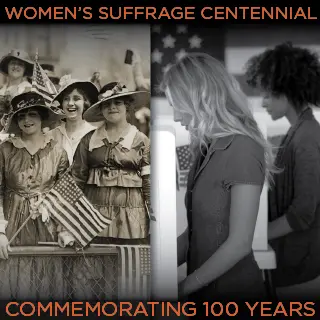100 Years of Women’s Suffrage: Commemorating and Honoring Real Life SHEroes

Today, more than 68 million women vote in elections because of suffragists who fought for the 19th Amendment to the U.S. Constitution, which was passed by Congress on June 4, 1919, ratified on August 18, 1920, and became law 100 years ago on August 26, 1920. And, August 6th marked the 55th anniversary of the Voting Rights Act, prohibiting racial discrimination in voting. We have come a long way, as indigenous Americans, black Americans and citizens representing other minority groups now also have the right to vote.
To mark the 100th anniversary of the 19th amendment, which effectively gave white women the right to vote, we thought it was worth exploring the history and honoring the trailblazers who set the wheels of progress in motion.
The word suffrage derives from the Latin word suffragium, which initially meant “a voting-tablet,” “a ballot,” “a vote” or “the right to vote.” During the women's suffrage movement in the U.S. (ca. 1848-1920), "suffragists" were anyone—male or female—who supported extending the right to vote (suffrage) to women.
Most supporters of women’s rights were introduced to reform efforts through the abolition movement of the 1830s. Among such prominent female abolitionists were Lucretia Mott and Elizabeth Cady Stanton, who were forced to sit in the gallery with all the other women and barred from participating in the World Anti-Slavery Convention in London in 1840. This experience led them to organize the first U.S. women's rights convention at Seneca Falls, New York eight years later.
Hundreds of women and men met in Seneca Falls in July 1848 with the intended purpose of discussing “the social, civil, and religious condition and rights of women.” Following the Seneca Falls Convention, many national women’s right conventions were held annually focusing on women's suffrage. Over 70 years later on May 21, 1919, the House of Representatives proposed a resolution granting women the right to vote, which passed 304 to 89— 42 votes above the required two-thirds majority. Two weeks later, on June 4, 1919, the Senate passed the 19th Amendment by two votes over its two-thirds required majority, 56-25.
The 19th Amendment was then sent to the states for ratification by three-fourths of the states, which in 1919 was 36 of the 48 states (Alaska and Hawaii were still U.S. territories). While some states ratified the amendment right away, others took longer and some outright rejected the amendment. Tennessee tipped the scale on August 18, 1920 and became the 36th and final state necessary to secure ratification, and the 19th Amendment was adopted on August 26, 1920. Note, however, that it was primarily a victory for white women, as many nonwhites—women and men—still faced huge barriers to voting until the passage of the Voting Rights Act of 1965, which prohibited racial discrimination in voting.
Even so, the 19th Amendment was a historic step in women’s suffrage and voting rights in the U.S., and one that Congress has celebrated in the years since. In 1973, Congress approved H.J. Res. 52, which stated that August 26 would be designated as Women’s Equality Day “in commemoration of that day in 1920 on which the women in America were first guaranteed the right to vote.” Most recently, in April 2017, Congress created the Women’s Centennial Commission to “ensure suitable observance of the centennial of the passage and ratification of the 19th Amendment”— learn more here!






